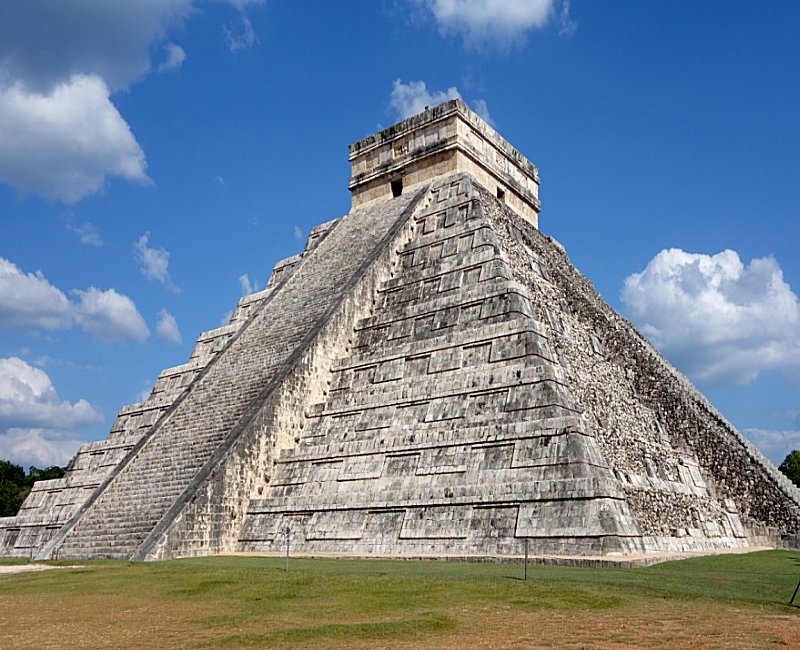Kukulkan (Quetzalcoatl): Feathered Serpent And Mighty Snake God
A. Sutherland - AncientPages.com - Known under several different names, Kukulkan (also Kukulcan), the Feathered Serpent, was one of the most important gods in Mesoamerica.
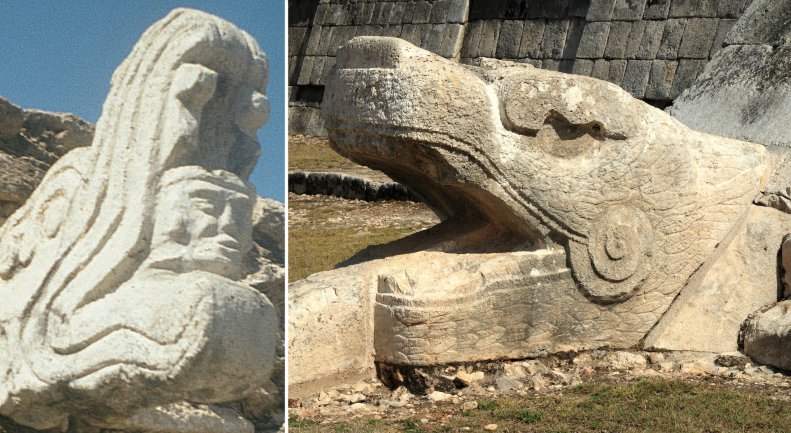 Left: Ballcourt marker from the Postclassic site of Mixco Viejo in Guatemala. This sculpture depicts Kukulkan, jaws agape, with the head of a human warrior emerging from his maw. Iamge credit: Simon Burchell - CC BY-SA 3.0; Right: Kukulkan at the base of the west face of the northern stairway of El Castillo, Chichen Itza. Image credit: Frank Kovalchek - CC BY 2.0
Left: Ballcourt marker from the Postclassic site of Mixco Viejo in Guatemala. This sculpture depicts Kukulkan, jaws agape, with the head of a human warrior emerging from his maw. Iamge credit: Simon Burchell - CC BY-SA 3.0; Right: Kukulkan at the base of the west face of the northern stairway of El Castillo, Chichen Itza. Image credit: Frank Kovalchek - CC BY 2.0
The Aztecs called him Quetzalcoatl, and the ancient Maya called him Kukulkan. The K'iche' group of Maya named him Gukumatz.
Was this mighty snake deity a genuine historical person?
It is not easy to trace the ancient history of Kukulkan. Like all of the feathered serpent gods in Mesoamerican cultures, Kukulkan is thought to have originated in Olmec mythology, and we still know very little about the mysterious Olmec civilization.
The true identity of the god Kukulkan becomes an even more significant problem due to the confusing references to a man who bore the name of the Mayan god. Because of this, the distinction between the two has become blurred.
Westside of the Temple of Kukulcan. Image credit: Luka Peternel - CC BY-SA 4.0
Around the 10th century, a priest or ruler appeared in Chichen Itza. This sacred site was one of the most potent Mayan centers of the Yucatán peninsula, Mexico, where we find El Castillo, also known as the Temple of Kukulkan.
Depicted as a serpent with feathers, Kukulkan showed up on many Mayan temples. This god later on became adopted by the Aztecs and Toltec people, and his name changed to Quetzalcoatl.
El Castillo square in plan and reaching 30 meters in height dominates the Main Plaza, and is the spectular structure at Chichen Itza. The temple was dedicated to the Feathered Serpent, Quetzalcoatl (known locally as Kukulkan). This deity is of Central Mexican origin and assumed a preeminent position in the pantheons of Teotihuacan and Toltec Tula.
Attesting to this dedication, low stone railings flanking the principal staircase on the northeastern side, those facing the Venus Platform, terminate in carved heads of Feathered Serpents.
Kukulkan originated among the Maya of the Classic Period (200 AD to 1000) when he was known as Waxaklahun Ubah Kan, the War Serpent. Maya writers of the 16th century describe Kukulkan as a historical person. Still, the earlier 9th-century texts at Chichen Itza never identified him as human, and artistic representations depicted him as a Vision Serpent entwined around the figures of nobles.
According to ancient Maya beliefs, Kukulkan - popularly known as the Feathered Serpent - was the god of the wind, sky, and the Sun. In Aztec culture and literature, he was a supreme leader of the gods, depicted just like Quetzalcoatl, whose name originates from the Nahuatl language and means "Precious serpent" or "Quetzal-feathered Serpent." Kukulkan gave humanity his learning and laws. He was merciful and kind but could also change his nature and inflict great punishment and suffering on humans.
According to Maya legend, the Maya were visited by a robed Caucasian man with blond hair, blue eyes, and a beard, who taught the Maya about agriculture, medicine, mathematics, and astronomy. This being was Kukulkan – the Feathered Serpent.
Kukulcan warned the Maya of another bearded white man who would not only conquer the indigenous people of Central America but would also enforce a new religion upon them before he was to return. Despite the warning, the Maya mistakenly welcomed the invading Cortes as Quetzalcoatl.
The cult of Kukulkan spread as far as the Guatemalan Highlands, where Postclassic feathered serpent sculptures are found with open mouths from which protrude the heads of human warriors.
Hundreds of North and South American Indian and South Pacific legends tell of a white-skinned, bearded lord who traveled among the many tribes to bring peace about 2,000 years ago. This spiritual hero was best known as Quetzalcoatl.
Some of his many other names were:
Kate-Zahl (Toltec)
Kul-kul-kan (Maya)
Tah-co-mah (NW America)
Waicomak (Dakota)
Wakea (Cheyenne, Hawaiian, and Polynesian)
Waikano (Orinoco)
Hurakan, the Mighty Mexico,
E-See-Co-Wah (Lord of Wind and Water)
Chee-Zoos
the Dawn God (Puan, Mississippi)
Hea-Wah-Sah (Seneca),
Taiowa, Ahunt Azoma
E-See-Cotl (New Guinea)
Itza-Matul (Yucatan)
Zac-Mutul (Mayan)
Wakon-Tah (Navajo)
Wakona (Algonquin)
Kukulkan emerged from the ocean and disappeared in it afterward. Before he left, he promised to return someday, but he never revealed when.
Written by – A. Sutherland - AncientPages.com Senior Staff Writer
Updated on February 13, 2024
Copyright © AncientPages.com All rights reserved. This material may not be published, broadcast, rewritten or redistributed in whole or part without the express written permission of AncientPages.com
Expand for referencesReferences:
Nichols, Deborah L. The Oxford Handbook of Mesoamerican Archaeology
Sierras E. The Shadow of Kukulkan
More From Ancient Pages
-
 Grinding Stone Sheds New Light On The Diet Of Early Neolithic Farmers In Scandinavia
Archaeology | Dec 30, 2024
Grinding Stone Sheds New Light On The Diet Of Early Neolithic Farmers In Scandinavia
Archaeology | Dec 30, 2024 -
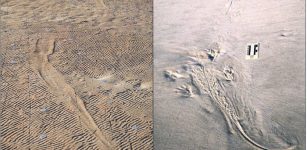 Ancient Giant Amphibians Swam Like Crocodiles 250 Million Years Ago – New Study
Archaeology | Mar 31, 2023
Ancient Giant Amphibians Swam Like Crocodiles 250 Million Years Ago – New Study
Archaeology | Mar 31, 2023 -
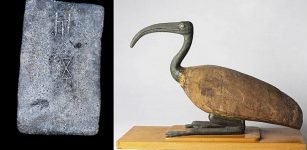 Has The Mystery Of Bronze Age Tin Been Solved?
Archaeology | Oct 3, 2019
Has The Mystery Of Bronze Age Tin Been Solved?
Archaeology | Oct 3, 2019 -
 Rare Pre-Columbian Archaic Settlement Discovered In The Dominican Republic May Solve A Caribbean Mystery
Archaeology | Apr 12, 2022
Rare Pre-Columbian Archaic Settlement Discovered In The Dominican Republic May Solve A Caribbean Mystery
Archaeology | Apr 12, 2022 -
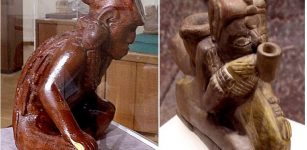 Unsolved Prehistoric Enigma Of Sophisticated Spiro People And Their Mysterious Mounds
Civilizations | Oct 25, 2018
Unsolved Prehistoric Enigma Of Sophisticated Spiro People And Their Mysterious Mounds
Civilizations | Oct 25, 2018 -
 Ancient Mystery Of The Massive, Astronomically Oriented Buildings Worldwide
Ancient Mysteries | Nov 29, 2025
Ancient Mystery Of The Massive, Astronomically Oriented Buildings Worldwide
Ancient Mysteries | Nov 29, 2025 -
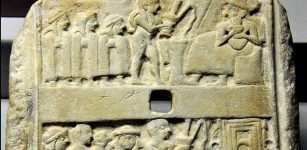 Ur – One Of The Largest And Most Important Cities Of Ancient Mesopotamia
Featured Stories | Jul 28, 2021
Ur – One Of The Largest And Most Important Cities Of Ancient Mesopotamia
Featured Stories | Jul 28, 2021 -
 Where Does The Expression ‘Saved By A Bell’ Come From?
Ancient History Facts | Oct 16, 2019
Where Does The Expression ‘Saved By A Bell’ Come From?
Ancient History Facts | Oct 16, 2019 -
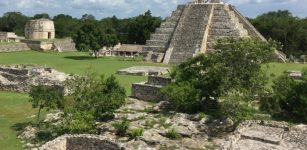 Drought Triggered Civil Conflict Among The Ancient Maya – Study
Archaeology | Jul 20, 2022
Drought Triggered Civil Conflict Among The Ancient Maya – Study
Archaeology | Jul 20, 2022 -
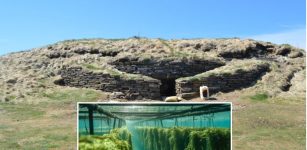 Ancient Europeans Ate Seaweed And Freshwater Plants – Evidence Found
Archaeology | Oct 17, 2023
Ancient Europeans Ate Seaweed And Freshwater Plants – Evidence Found
Archaeology | Oct 17, 2023 -
 Our Understanding Of Human Prehistory And Societies Is Wrong – Scientists Say
Featured Stories | Nov 3, 2022
Our Understanding Of Human Prehistory And Societies Is Wrong – Scientists Say
Featured Stories | Nov 3, 2022 -
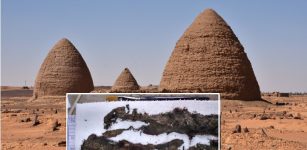 People Of Old Dongola Recycled And Dyed Clothes
Archaeology | Jan 24, 2024
People Of Old Dongola Recycled And Dyed Clothes
Archaeology | Jan 24, 2024 -
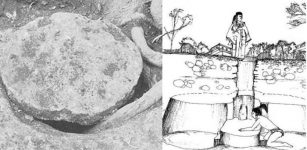 Mysterious Chultuns – Ancient Underground Chambers Built By The Maya – But For What Purpose?
Featured Stories | Jun 24, 2017
Mysterious Chultuns – Ancient Underground Chambers Built By The Maya – But For What Purpose?
Featured Stories | Jun 24, 2017 -
 Bones Of Giants Unearthed In Ancient Cave
Ancient Mysteries | Sep 23, 2018
Bones Of Giants Unearthed In Ancient Cave
Ancient Mysteries | Sep 23, 2018 -
 Will Egypt be able to buy back the 4500-year-old statue of Sekhemka?
Artifacts | Aug 26, 2015
Will Egypt be able to buy back the 4500-year-old statue of Sekhemka?
Artifacts | Aug 26, 2015 -
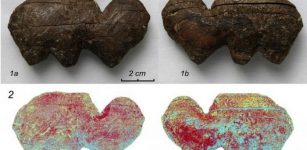 Ancient Mammoth Ivory Carving Technology Of Master Craftsmen – Reconstructed
Archaeology | Aug 27, 2020
Ancient Mammoth Ivory Carving Technology Of Master Craftsmen – Reconstructed
Archaeology | Aug 27, 2020 -
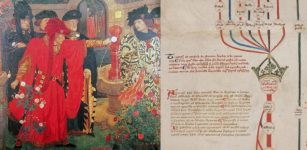 Unique Canterbury Roll – Ancient Manuscript Reveals Its Secrets About History Of England
Archaeology | Jan 5, 2018
Unique Canterbury Roll – Ancient Manuscript Reveals Its Secrets About History Of England
Archaeology | Jan 5, 2018 -
 Previously Assumed Turkic Origin Of The European Huns – Refuted; They Had Ancient Siberian Roots
Linguistic Discoveries | Jun 18, 2025
Previously Assumed Turkic Origin Of The European Huns – Refuted; They Had Ancient Siberian Roots
Linguistic Discoveries | Jun 18, 2025 -
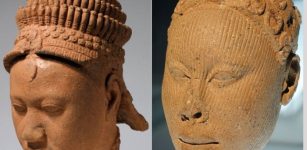 Ife Head: Significance Of The Head ‘Ori’ In Yoruba Ancient And Present Beliefs
Artifacts | Mar 27, 2019
Ife Head: Significance Of The Head ‘Ori’ In Yoruba Ancient And Present Beliefs
Artifacts | Mar 27, 2019 -
 Grave Of Amazon Warrior Who Lived In The Kingdom Of Urartu Discovered In Armenia
Archaeology | Nov 28, 2019
Grave Of Amazon Warrior Who Lived In The Kingdom Of Urartu Discovered In Armenia
Archaeology | Nov 28, 2019

